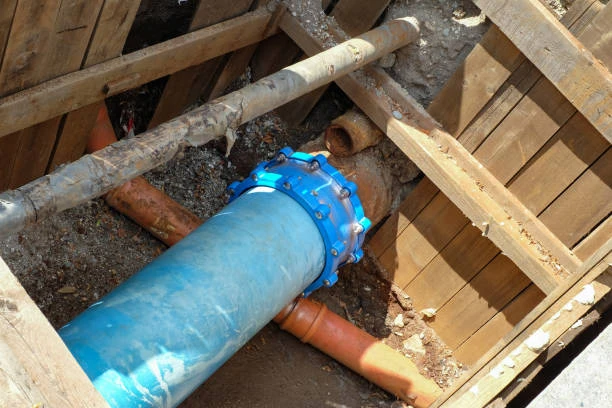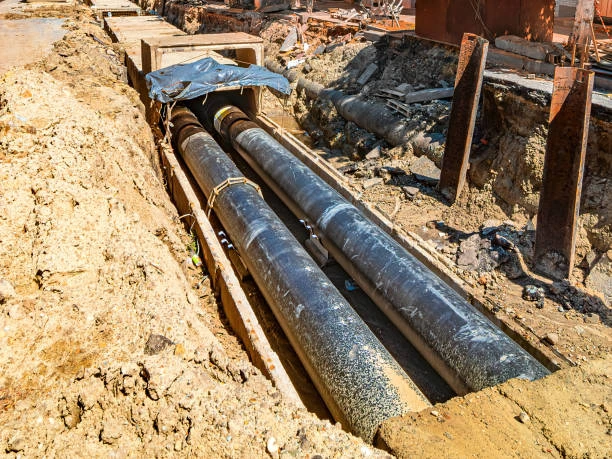A recent incident in southern Sydney shocked residents and raised serious concerns about the aging infrastructure of the city’s water supply system. A burst water pipe sent torrents of Water pipe into nearby homes, causing extensive damage and disrupting daily life. Footage of the event, now widely shared on social media, shows a massive flood of water gushing into homes, damaging property and leaving many without a reliable water supply.
This devastating event highlights the risks associated with aging water pipelines and the importance of maintaining and upgrading plumbing infrastructure. In this article, we’ll examine the causes of water pipeline bursts, the aftermath of the incident in southern Sydney, and how to prevent such disasters in the future.

The Burst Water Pipe Incident: A Closer Look
On a typical Sydney morning, residents in a southern suburb were jolted by a loud rumbling noise, followed by the sudden onrush of water flooding their homes. The burst water pipe, which had been carrying the local water supply, ruptured unexpectedly, sending a wall of water into nearby properties. Video footage captured by residents quickly went viral, showing water surging into homes, damaging furniture, walls, and electronics.
The Immediate Impact
The aftermath of the burst water pipe was both chaotic and devastating. Multiple homes were affected by the sudden influx of water. In some cases, the floodwaters rose so quickly that homeowners had no time to salvage their belongings. While no lives were lost, the property damage was significant, and many families were displaced temporarily as repair work was carried out.
Aside from the direct damage caused by flooding, the rupture also resulted in an interruption of water supply to the affected areas. This caused significant inconvenience to local residents who were left without access to water for several hours or days, depending on the extent of the repair work.
The Causes of Burst Water Pipe
While the footage of the burst water pipe in southern Sydney was shocking, pipeline ruptures are unfortunately not uncommon. A variety of factors can contribute to a burst water pipe. Understanding the causes is essential for taking preventive measures to avoid similar incidents in the future.
1. Aging Infrastructure
In many older cities, including Sydney, much of the water pipeline infrastructure was built decades ago, and the pipes are nearing or have exceeded their expected service life. Materials such as cast iron, steel, and concrete, commonly used in older water pipelines, are prone to wear and corrosion over time. As pipes degrade, they become more susceptible to bursts under pressure, particularly in high-stress areas like joints and connections.
2. Corrosion and Wear
Water pipes are constantly exposed to moisture, and over time, this can lead to rust and corrosion, weakening the structural integrity of the pipe. Corrosion is particularly problematic in areas with hard water, as the mineral deposits can accelerate the degradation of pipes. Once pipes begin to corrode, small cracks or holes can develop, eventually leading to a rupture.
3. High Water Pressure
Excessive water pressure can place undue stress on pipes, making them more likely to fail. If the pressure in a water pipe exceeds the pipe’s designed capacity, it can cause the pipe to burst. Older pipes are especially vulnerable to high-pressure surges, which may result from sudden changes in demand or malfunctioning pressure regulators.
4. Temperature Fluctuations
In regions that experience extreme temperature fluctuations, frozen pipes are a significant risk. When the water inside a pipe freezes, it expands, creating internal pressure that can cause the pipe to crack or rupture. As the weather warms and the ice melts, the damage can become more apparent, often resulting in a sudden burst.
5. External Stress
Pipes buried underground are susceptible to external pressures, such as shifting soil, construction activity, or even tree root infiltration. Any external force that disrupts the integrity of the pipe can increase the risk of a burst. Similarly, if the pipe has been poorly installed or subjected to heavy traffic above the ground, it may become compromised.
How a Burst Water Pipe Affects Homes and Communities
The consequences of a burst water pipe can be far-reaching, affecting not just individual homes but entire neighborhoods. Here’s how the event in southern Sydney impacted both the local community and individual residents:
1. Property Damage
The most immediate and visible effect of a burst water pipe is the property damage. As shown in the video footage, the rush of water can quickly flood rooms, causing significant damage to flooring, walls, furniture, and electronics. Homeowners may find themselves facing costly repairs and replacements, depending on the severity of the flooding.
2. Health and Safety Risks
Floodwaters can present health risks, especially if the water is contaminated with bacteria or sewage. Water damage can also lead to mold growth, which, if left untreated, can pose long-term health risks, including respiratory issues and allergies.
3. Loss of Water Supply
In addition to the direct flooding, a burst water pipe often leads to the temporary loss of water supply in the affected area. For residents, this means being without running water for an extended period—often for several hours or even days—until repairs are completed. This disruption can severely impact daily life, from cooking and cleaning to basic hygiene.
4. Increased Costs
The financial implications of a burst water pipe extend beyond the immediate property damage. Homeowners often need to pay for repairs to both the plumbing and the water-damaged property. Additionally, the costs of professional cleanup, temporary accommodation, and lost productivity due to the inconvenience can add up quickly.
5. Environmental Impact
Water wastage is another issue associated with burst pipes. The rupture of a major pipeline can result in significant water loss, particularly if the leak is not identified and fixed immediately. This not only wastes a valuable resource but also strains local water supplies.
Preventing Burst Water Pipe: How to Protect Your Home
The catastrophic events of a burst water pipe in southern Sydney may be a wake-up call for many homeowners and city planners alike. Preventing such incidents requires a proactive approach to pipeline maintenance, pipe upgrades, and early detection of problems. Here are some strategies to reduce the risk of burst pipes:
1. Upgrade Aging Pipes
Replacing old water pipes with modern materials like PEX (cross-linked polyethylene) or CPVC (chlorinated polyvinyl chloride) can significantly reduce the risk of rupture. These materials are more durable, flexible, and resistant to corrosion, making them ideal for water pipelines.
2. Regular Inspections and Maintenance
Routine inspections by a licensed plumber can help identify signs of wear or corrosion before they lead to a burst. If your home is part of a larger network of water pipes, municipal authorities should also conduct regular checks to ensure the system is functioning correctly and to address potential issues early.
3. Water pipe Pressure Regulation
Installing a water pressure regulator can help prevent excessive pressure in the pipes. If your local water supply has high pressure, this device can help ensure that the pressure stays within safe limits, reducing the strain on the pipes and preventing burst incidents.
4. Water pipe Proper Insulation
If you live in an area prone to freezing temperatures, make sure your water pipes are properly insulated to prevent them from freezing and bursting. There are various insulation materials available that can protect pipes from extreme cold.
5. Water pipe Use Modern Plumbing Technologies
Advancements in plumbing technology, such as trenchless pipe repair and pipe relining, allow for the repair or replacement of damaged pipes without the need for extensive digging. These methods can help extend the lifespan of your plumbing system and prevent future failures.
Conclusion
The recent burst water pipe incident in southern Sydney is a stark reminder of the importance of maintaining and upgrading water pipelines. Aging infrastructure, high water pressure, and environmental factors can all contribute to pipeline failures, which can have devastating consequences for homeowners and entire communities. By upgrading old pipes, conducting regular inspections, and taking preventive measures, we can reduce the risk of future water pipeline bursts and ensure a reliable water supply for all.
Frequently Asked Water pipe Questions (FAQs)
1. What causes a water pipe to burst?
A water pipe can burst due to a variety of factors, including aging infrastructure, corrosion, excessive water pressure, freezing temperatures, and external stress. Regular maintenance can help prevent such issues.
2. How can I prevent my water pipes from bursting?
To prevent burst pipes, consider upgrading old pipes, installing pressure regulators, insulating exposed pipes, and scheduling regular plumbing inspections.
3. What should I do if I experience a burst water pipe?
If you experience a burst water pipe, immediately turn off the water pipe supply and contact a professional plumber for repairs. Take steps to minimize water damage, such as moving valuables to higher ground.
4. How much water is lost in a burst pipe?
A burst pipe can result in significant water loss, especially if the rupture is large or left unrepaired for an extended period. The amount of water lost depends on the size of the pipe and the duration of the leak.
5. Is it safe to stay in my home after a burst water pipe?
If flooding occurs, it may pose health and safety risks due to potential contamination or structural damage. It’s best to stay out of the affected area until repairs are made and the situation is assessed by a professional.


















